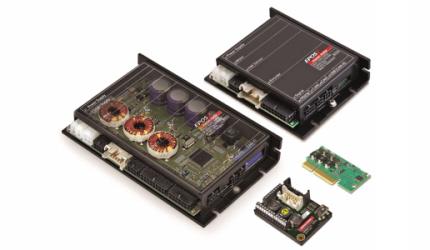The solution came about following a consolidation of technology within Emerson Industrial Automation, replacing the individual approach to its brands in the past. Most notably for this machine building application is the convergence of motor control from Control Techniques and fluid automation from ASCO Numatics.
Resulting from this shared expertise is the Unidrive M800 – the company's most powerful machine controller. It is essentially created by adding a MCi machine controller to its existing top of the range M700 drive.
Stewart Dowsett, UK sales manager for the manufacturing team at Emerson Industrial Automation, commented: "Instead of having a separate PLC and a whole bunch of drives, what we have done is taken a lot of technology that is onboard a PLC and we have installed it on what we term a machine controller. The machine controller is effectively a drive and a PLC all in one box."
It takes a shift of different mindset for the machine builder believes Dowsett. " I just don't think anybody has done it before. Traditionally people have a PLC that sends a signal to a valve island, which then does its stuff and send a signal back to the PLC. That same PLC would be controlling our drives." The starting, and central, point was the PLC.
While individual PLCs will have different levels of performance and attributes, they are in general, compared to an intelligent drive, less efficient to run, more expensive and use a proprietary programming environment. Being able to simply remove such a pivotal item of equipment clearly reduces the complexity of the whole system.
"In terms of energy, you do have the secondary processor on the drive but typically that is going to be a more efficient to operate than a PLC, which needs to be kept running. We can shut down the drives when they are not operating - put them in standby very quickly - and that is very efficient in terms of saving electrical costs." Dowsett went on to claim: "Inherently our drive is more efficient than others and much, much more efficient than running a PLC."
Comparing the performance of the drive with that of a PLC is ignoring its key advantage. Dowsett said: "This is nothing new for Control Techniques. With the SP drive – our older technology – we have had this ability to manage IO, and so some customers stopped using a PLC. The obvious benefit of this is a reduced component count, reduced cost in manufacture and then reduced complexity in the actual assembly of a machine. A drive used to be simply a method of controlling a motor turning. It is now evolving with more intelligence and functionality to take on the role of the PLC."
Another key difference is that PLCs are programmed in the suppliers proprietary language, therefore requiring a very specific skill set. These new intelligent drives are programmed in Codesys, an open software that supports a number of other IEC 61131-3 programming languages, making program migration easy. Becoming the norm amongst the drive suppliers, Codesys brings with it an open-source community with numerous function blocks in addition to Emerson's own Machine Control Studio library, and the library that can be built up by the user.
Dowsett said: "If you look at a lot of our competitors now we are all starting to use Codesys as the primary programming language. Codesys is now being taught in schools and colleges, so what we are giving customers who choose our product is a huge talent bank - they can effectively call on people coming out of colleges."
"We can now link the electrical elements and the pneumatic elements together, and as far as we are aware no other manufacturer has been able to do that," summed up Dowsett. "Typically drive manufacturers are drive manufacturers and pneumatic manufacturers are pneumatic manufacturers. Because of the Emerson Industrial Automation brand we have the benefit of having both of those product ranges available so we have linked them together to demonstrate how we could use the valve terminal as the IO for the drive or for the system and we could drive the mechanical element i.e. the pneumatics, without the need for a PLC."
The first application of the new technology is currently being configured for a customer in Ipswich, but it is open to any system that requires a mixture of electrical and pneumatic control equipment. "The typical customer for this would be a machine builder in the packaging industry," added Dowsett. "The mixture in packaging [between pneumatic and electrical] is a good split for us."
More motor options
he maxon motor EPOS2 motion controllers for brushed and brushless DC motors can now be used in a broader range of applications. Deployment of computer-based motor drives, rather than traditionally used PLC systems, isbecoming more prevalent. Maxon motor EPOS2 positioning controllers now support CANopen interfaces Kvaser and NI-XNET, in addition to NI, IXXAT and Vector. There are also opportunities for computer platforms with serial communication, via USB or RS232, using Windows or Linux. The existing libraries for Intel/AMD (Windows 32/64bit, Linux 32bit) have been extended with a Linux 64bit version, with additional support of 32bit ARMv6/v7 solutions, allowing broad scale use within trend platforms, such as Raspberry Pi and BeagleBone. |












